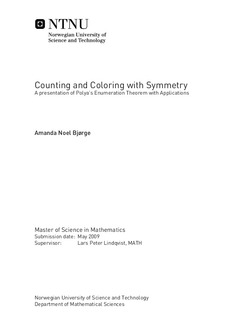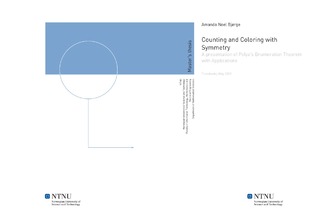| dc.contributor.advisor | Lindqvist, Lars Peter | nb_NO |
| dc.contributor.author | Bjørge, Amanda Noel | nb_NO |
| dc.date.accessioned | 2014-12-19T13:58:03Z | |
| dc.date.available | 2014-12-19T13:58:03Z | |
| dc.date.created | 2010-09-04 | nb_NO |
| dc.date.issued | 2009 | nb_NO |
| dc.identifier | 348745 | nb_NO |
| dc.identifier | ntnudaim:4381 | nb_NO |
| dc.identifier.uri | http://hdl.handle.net/11250/258478 | |
| dc.description.abstract | This master's thesis explores the area of combinatorics concerned with counting mathematical objects with regards to symmetry. Two main theorems in this field are Burnside's Lemma and P'{o}lya's Enumeration Theoremfootnote{P'{o}lya's Enumeration Theorem is also known as Redfield--P'{o}lya's Theorem.}. Both theorems yield a formula that will count mathematical objects with regard to a group of symmetries. Burnside's Lemma utilizes the concept of orbits to count mathematical objects with regard to symmetry. As a result of the Burnside Lemma's reliance on orbits, implementation of the lemma can be computationally heavy. In comparison, P'{o}lya's Enumeration Theorem's use of the cycle index of a group eases the computational burden. In addition, P'{o}lya's Enumeration Theorem allows for the introduction of weights allowing the reader to tackle more complicated problems. Building from basic definitions taken from abstract algebra a presentation of the theory leading up to P'{o}lya's Enumeration Theorem is given, complete with proofs. Examples are given throughout to illustrate these concepts. Applications of this theory are present in the enumeration of graphs and chemical compounds. | nb_NO |
| dc.language | eng | nb_NO |
| dc.publisher | Institutt for matematiske fag | nb_NO |
| dc.subject | ntnudaim | no_NO |
| dc.subject | MMA matematikk | no_NO |
| dc.subject | Analyse | no_NO |
| dc.title | Counting and Coloring with Symmetry: A presentation of Polya's Enumeration Theorem with Applications | nb_NO |
| dc.type | Master thesis | nb_NO |
| dc.source.pagenumber | 49 | nb_NO |
| dc.contributor.department | Norges teknisk-naturvitenskapelige universitet, Fakultet for informasjonsteknologi, matematikk og elektroteknikk, Institutt for matematiske fag | nb_NO |

